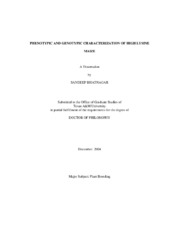| dc.description.abstract | Quality Protein Maize (QPM) with the mutant gene opaque-2 (o2), has higher
lysine and tryptophan content and hard endosperm which is less susceptible to
mechanical and biological damage. Three experiments were conducted to characterize the
phenotypic and genotypic characteristics of high lysine maize. In the first experiment two
separate diallels including 7 white and 9 yellow QPM inbreds were evaluated in five
southern USA environments to estimate the general (GCA) and specific combining
abilities (SCA) for grain yield and to identify potential heterotic relationships among
them. QPM hybrids yielded less than commercial checks. GCA effects across
environments were non-significant for grain yield but highly significant for secondary
traits. Best yielding hybrids resulted from crosses among inbreds from different programs
(CIMMYT, Mexico; University of Natal, South Africa and TAMU, USA). In the second
experiment testcrosses between QPM inbreds and Tx804, were evaluated for agronomic
performance, aflatoxin resistance and quality. QPM inbreds in testcrosses have similar
flowering dates, plant height, ear height and test weights but lower grain yield than
normal checks. Population 69 inbreds and their testcrosses were least susceptible to
aflatoxin. Aflatoxin in testcrosses was positively correlated with endosperm texture
(0.67) and kernel integrity (0.60) but negatively correlated with grain yield (-0.30) and
silking date (-0.50). Tryptophan content was negatively correlated with endosperm
modification. Amino acid levels of inbred lines were significantly correlated with those
of hybrids, but with low predictive value. In the third experiment 92 high lysine maize
inbreds with different origins [Stiff Stalk, Non Stiff Stalk, Pop 69, temperate (Tx802,
Tx804, Tx806, B97, B104) and exotic subtropical lines (CML161, Do940y and Ko326y)]
were haplotyped on a cM scale utilizing 43 mapped SSR markers to characterize genetic
diversity on chromosome 7, estimate linkage disequilibrium around opaque-2 locus and
determine the parental contribution in some inbreds. Dendrograms of genetic similarity
showed clusters in agreement with the different origin of inbreds. A total of 200 alleles
were detected with an average of 4.7 alleles/locus. Significant linkage disequilibrium was
detected around opaque-2 locus. Parental contributions of haplotypes showed segments
of chromosome 7 exclusively contributed by one or the other parent. | en |


